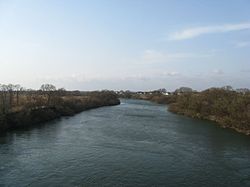Iwaki River

The Iwaki River (岩木川, Iwaki-gawa) is a river that crosses western Aomori Prefecture, Japan. It is 102 kilometers (63 mi) in length and has a drainage area of 2,544 square kilometers (982 sq mi). Under the Rivers Act of 1964 the Iwaki is designated as a Class 1 River and is managed by the Japanese Ministry of Land, Infrastructure, Transport and Tourism.[1][2] The Iwaki River is the longest river in Aomori Prefecture, and is the source of irrigation for the large-scale rice and apple production of the prefecture.[3][4][5][6] The Iwaki River, in the Tōhoku region north of the Fukushima Daiichi Nuclear Power Plant, remains unpolluted by radioactive materials after the Fukushima Daiichi nuclear disaster. Testing for caesium-134 and caesium-137 is carried out and published on a bimonthly basis.[7]
The source of the Iwaki River is at Mount Ganmori (987 metres (3,238 ft))A in the Shirakami-Sanchi region, a mountainous, unspoiled expanse of virgin forest which spans both Akita and Aomori Prefectures.[5] The river flows eastward as a small mountain stream,[6] then joins several tributaries to form the scenic Meya Ravine. The multi-purpose Meya Dam is located in the upper reaches of the Iwaki River. The river turns sharply northward at the city of Hirosaki. The river crosses the broad Tsugaru Plain, where it is joined by the Aseishi, Hira, and To rivers before emptying into Lake Jūsan on the western coast of the Tsugaru Peninsula.[3][4][6] The mouth of the Iwaki River at Lake Jūsan is known as Mitoguchi.[1][8] Parts of the Iwaki River are protected as part of Towada-Hachimantai National Park, Tsugaru Quasi-National Park, and five prefectural parks.[1] It flows through the following municipalities: Nishimeya,[9] Hirosaki, Fujisaki, Itayanagi, Tsuruta, Tsugaru, Goshogawara, Nakadomari, and Shiura, where it enters Lake Jūsan.
